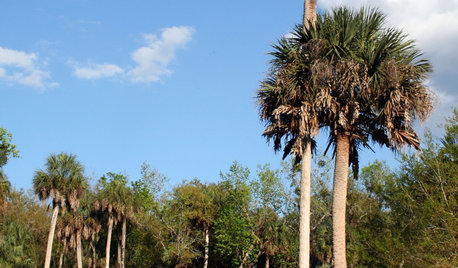Canary Island Date Palms ravaged by non-native beetle
August 29, 2006
{{gwi:419789}}
Tenerife Journal
In Natures Immigration Fight, Newcomers Battle Natives
By RENWICK McLEAN
TENERIFE, Canary Islands  It rains little on this island. There are no natural rivers, and the air is full of the dry heat of the nearby Sahara.
But in a ravine on the islandÂs northern tip, tree limbs drip with water and a tropical forest flourishes, sustained almost entirely by condensation from the low-lying clouds that are regularly pinned against the mountainside.
The area, called Cruz del Carmen, is only one example of the unusual evolutionary habitats on the Canary Islands that fascinated Charles Darwin more than 100 years ago, and that today reveal a new species or subspecies to scientists an average of once every six days.
But the unique plant and animal life here is being steadily overtaken by an invasion of foreign species, which have been entering these Spanish islands in increasing numbers since border checkpoints within the European Union were abolished under the Schengen Agreement a decade ago, according to government officials and scientists here.
"There is very potent legislation controlling what enters into Europe," José Luis MartÃn Esquivel, a scientist at the regional governmentÂs Center for Environmental Planning in Tenerife, said in an interview. "But there are very weak controls on what crosses the borders within Europe."
The ecological problem is another example of the Schengen treatyÂs unexpected consequences for these islands, which have been struggling in recent months with waves of West African immigrants seeking to reach mainland Europe through the porous borders separating the islands from the rest of the European Union.
Government officials on the islands, about 70 miles off the coast of southern Morocco, say that an invasive species enters their borders about once every 17 days, and that one of those turns into a plague capable of altering native habitats, and seriously threatening native species, an average of once every six months.
Over all, about 4,000 endemic, or native, plant and animal species have been recorded on the Canary Islands, compared with about 100 for all of Britain, according to the regional governmentÂs database on biodiversity. But the true number could be considerably larger, since dozens of new species are found every year, government officials say.
The species include giant lizards, grasshoppers without wings and some of the few remaining relics of the laurel forests that covered large parts of the Mediterranean basin 20 million years ago.
The natural wonders of these islands have drawn researchers for centuries. Darwin dreamed of a visit in the 1830Âs. His "Canary scheme," as he called it, was far enough along that he had begun studying Spanish, immersed himself in scientific writings on the islands and prepared to reserve a ticket on a ship bound for them.
But months before he was to go, he was appointed to a position on the Beagle and went to the Galápagos Islands instead.
The richness of the islands biodiversity is most evident in Cruz del Carmen, which has the highest concentration of native species in Europe, according to a recent study by the regional government.
As the road to Cruz del Carmen winds upward from the parched flatlands, a chilly fog darkens the landscape and daylight seems to turn to dusk. Drivers flip on their headlights, and passers-by, who were dressed in T-shirts and bathing suits only a few miles back, wear sweaters and jackets.
Thousands of gallons of water condense in the mountains here every day, local scientists say, helping to create conditions that have led the plant and animal life down a unique evolutionary course.
A random handful of soil here can easily contain four or five endemic species of insects, said AgustÃn Aguiar Clavijo, a zoologist at the regional environmental center.
Yet, while Cruz del Carmen teems with unique life, other parts of the Canary Islands are being steadily overrun by invasive species.
The regional government estimates that invasive species have already cut the percentage of native plant species on the islands in half, to one of every four plants from one of every two.
Among the most notorious invaders are the Barbary ground squirrel, which has decimated plants on the island of Fuerteventura, and the Corsica mouflon, a type of wild sheep that was brought to Tenerife in the 1970Âs to stock the forests for hunting.
The most recent threat comes from a beetle called the picudo rojo, which has been ravaging many of the islands signature Canary palm trees over the past year. The beetle appears to have spread from nonnative palm trees that were recently brought into the islands.
The regional government says about 20 endemic species are endangered. Several have fewer than 100 specimens left in the wild, and some have fewer than two dozen.
Domingo Berriel, the director of the regional governmentÂs environmental protection agency, said the best way to manage the threat to local habitats would be to give the regional government more authority to monitor what comes across its borders.
He said that the Schengen Agreement allowed for certain types of controls, but that so far they had been managed mainly by the central government in Madrid.
Madrid has failed to address the problem with enough urgency, Mr. Berriel said. "If we donÂt act soon," he said, "the consequences for our endemic species could be grave."
Copyright 2006 The New York Times Company









unautreOriginal Author
Related Professionals
Ilchester Landscape Architects & Landscape Designers · Marco Island Landscape Architects & Landscape Designers · Pottstown Landscape Contractors · Northport Landscape Contractors · Saint John Landscape Contractors · Weslaco Landscape Contractors · Palos Hills Landscape Contractors · Oxon Hill Landscape Contractors · Ansonia Landscape Contractors · Woodstock Carpenters · Cedar Hill General Contractors · Coronado General Contractors · Havre de Grace General Contractors · North New Hyde Park General Contractors · Spencer General Contractors